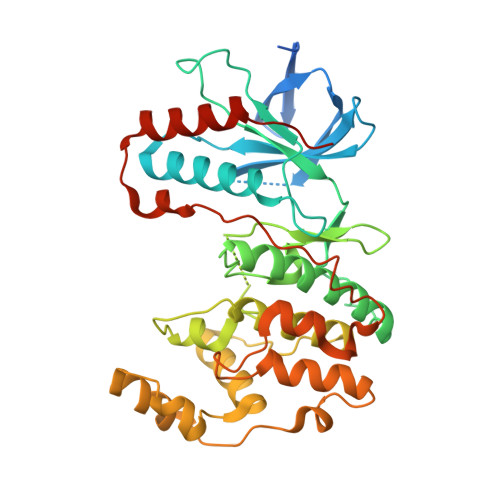Structure-Based Design, Synthesis, and Biological Evaluation of Imidazo[4,5-b]pyridin-2-one-Based p38 MAP Kinase Inhibitors: Part 1.
Kaieda, A., Takahashi, M., Fukuda, H., Okamoto, R., Morimoto, S., Gotoh, M., Miyazaki, T., Hori, Y., Unno, S., Kawamoto, T., Tanaka, T., Itono, S., Takagi, T., Sugimoto, H., Okada, K., Snell, G., Bertsch, R., Nguyen, J., Sang, B.C., Miwatashi, S.(2019) ChemMedChem 14: 1022-1030
- PubMed: 30945818
- DOI: https://doi.org/10.1002/cmdc.201900129
- Primary Citation of Related Structures:
6M95, 6M9L - PubMed Abstract:
We identified a lead series of p38 mitogen-activated protein kinase inhibitors using a structure-based design strategy from high-throughput screening of hit compound 1. X-ray crystallography of 1 with the kinase showed an infrequent flip of the peptide bond between Met109 and Gly110, which was considered to lead to high kinase selectivity. Our structure-based design strategy was to conduct scaffold transformation of 1 with maintenance of hydrogen bond interactions with the flipped hinge backbone of the enzyme. In accordance with this strategy, we focused on scaffold transformation to identify imidazo[4,5-b]pyridin-2-one derivatives as potent inhibitors of the p38 MAP kinase. Of the compounds evaluated, 21 was found to be a potent inhibitor of the p38 MAP kinase, lipopolysaccharide-induced tumor necrosis factor-α (TNF-α) production in human monocytic leukemia cells, and TNF-α-induced production of interleukin-8 in human whole blood cells. Herein we describe the discovery of potent and orally bioavailable imidazo[4,5-b]pyridin-2-one-based p38 MAP kinase inhibitors that suppressed cytokine production in a human whole blood cell-based assay.
- Pharmaceutical Research Division, Takeda Pharmaceutical Company Limited, 26-1, Muraoka-higashi 2-chome, Fujisawa, Kanagawa, 251-8555, Japan.
Organizational Affiliation:

















